





















|
King Chulalongkorn the
Great
Fond memories of a Great king
Next Tuesday, October 23, the Kingdom of Thailand
observes Chulalongkorn Day. It is a national holiday, and as such, all banks
and most offices will be closed for the day. The following is a tribute to a
great King in Thailand’s history.
 His
Majesty King Chulalongkorn the Great His
Majesty King Chulalongkorn the Great
His Majesty King Chulalongkorn the Great (Rama V) was
born in 1853, the son of His Majesty King Mongkut (Rama IV) and Her Majesty
Queen Thep Sirinthorn. In 1868, He was given the title Duke ‘Meun
Phikhartnaresueansurasangkas.’
King Chulalongkorn ascended the throne in 1868, with the
title ‘Phrabat Somdej Phra Paraminthra Maha Chulalongkorn Bodinthorn
Thep Phaya Maha Mongkut Burutsaya Ratanaraj Rawiwong Warut-tapong
Saboripatara Wora Khatiyaraj Nikarodom Jaturatana Borom Maha Chakarapaddiraj
Sangart Boromtammika Maha Raja Thiraj Boromanat Bopitara Phra Chulachomklao
Chao Yoo Hua’.
His Majesty King Chulalongkorn lived with one purpose in
his mind and heart: the happiness and well-being of the Siamese people. His
Majesty would often dress as a commoner and move among his people with only
two or three advisors. In this way, he could find out how his subjects
really felt and see what was happening in his Kingdom.
There is one famous story of His Majesty and two
counselors who, after a hard day’s travel, stopped at a farmer’s house
to ask for a drink of water. Rural hospitality being a hallmark of Thai
people, the family asked the three strangers to stay and have food with
them. Speaking freely, the farmer and his wife told the strangers of how
their life was progressing and what they would like to see done for their
village by the ‘Great King who lives in the Palace in Bangkok.’ The
farmer’s son noticed that one of the strangers looked familiar. He went
and looked at a daguerreotype the family had of the King. Running back to
the group, the family learned that they were serving food to the ‘Lord of
Life’ in Siam. King Chulalongkorn the Great did this often and thus became
‘in touch’ with the needs of the Siamese people.
Another story of the great love and respect happened in
1893. The territory hungry French had formulated a plan to take the Siamese
territory of Laos and certain valuable territories on the Eastern Seaboard
which produced precious rubies and sapphires.
In a carefully formulated plan, a French warship entered
the Chao Phraya River. It was required by international law that all foreign
ships fly their colors when entering the waters of another sovereign
country. The French deliberately did not do this. When hailed by the river
guard to fly their colors, the French ignored the guard. The guard fired a
warning shot over the French ship’s bow.
The French Embassy in Bangkok was prepared in advance to
carry out the plan. Bringing a letter sent from France months before the
incident, it stated that Siam had performed an act of aggression on the
French and must pay huge reparations.
The French were not prepared for what happened
next. Hearing of the huge demands, Siamese both wealthy and poor brought
cartloads of jewels, precious metals and every valuable possible to the
Royal Palace and offered it to His Majesty to keep the French out of Siam.
The French had not imagined that Siam was so wealthy and
the people so devoted to their King.
Siam was able to pay the reparations but the French,
deciding this was not enough, took all Siamese territory east of the Mekong
River.
His Majesty King Chulalongkorn was wise, knowing that
Siam could not resist the French and British and held the motto of ‘giving
up some so as not to lose all.’
Siam lost over 160,000 sq. kilometers of territory to the
French and British. She also knew that she was a ‘buffer’ state and it
was in these two countries interest to ‘use’ Siam.
His Majesty King Chulalongkorn was the first Siamese
monarch to visit the West. He believed in adopting all things good from the
West while Siam kept Her culture. The wise King Chulalongkorn made Russia a
strong ally of Siam to counteract the British and French influence in SE
Asia. He followed the Chinese concept of ‘have strong allies but make
sure their borders are far away.’
Many of the Royal Princes were sent to study in Russia.
In His letters to His sons, King Chulalongkorn wisely warned them ‘do not
feel that you are important because you are a prince. In Siam, there are
many Princes, whereas in Russia there are few. Do the best you can at your
studies and that is enough.’
King Chulalongkorn’s most noteworthy achievement in
Siam was the abolition of slavery. He did not do this in a haphazard manner
as it was done in other countries. He devised a complex method of
‘freeing’ slaves so that older ones would not be left in poverty with no
place to live. Younger slaves were to be released by ‘stages’,
responsibility falling to the owner to see that they had a way of supporting
themselves.
His Majesty King Chulalongkorn the Great is beloved of
Thai people and considered a truly ‘enlightened’ ruler among historians.
His Majesty died on October 25th, 1910, after the second longest reign in
the history of the Thai nation.
He is remembered and loved by the Thai people and the
date of his death is commemorated every year. Ceremonies are held, offerings
are made to his memory and the entire student body from the university that
bears his name perform obeisance before his statue.
Would that all countries were so lucky to have one such
enlightened ruler in their collective histories.
327 Girls - and one Boy
- Reach into the Future
Next time you are served by a charming young lady in one
of Pattaya’s leading hotels, she could well be a product of an ongoing
Youth Career Development Programme. Pattaya Mail special
correspondent Peter Cummins attended a graduation ceremony in Bangkok
recently and reports here on a most impressive ceremony launching 100 girls,
plucked from north-eastern poverty, onto a promising future.
story and photos by Peter Cummins
It was a sea of smiling, pretty faces and
‘heart-warming’ would be a totally inadequate description of the scene
of a graduation ceremony for future hotel service staff, held at the
Peninsula Bangkok recently.
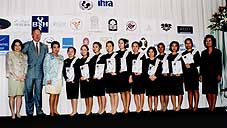 William
Sayce, GM, Pan Pacific and his new staff. Dr Kasama at far right William
Sayce, GM, Pan Pacific and his new staff. Dr Kasama at far right
As 100 poised, beautifully-groomed and most attractive
young ladies, outfitted in the uniforms of their recipient hotels, went up
to the stage to receive their diplomas, it was, rather, a
‘breath-taking’ spectacle. Dr. Kasama Varavarn na Ayudhya, director
general, Department of General Education, together with the general manager
of the hotel which had undertaken the training - and now employs that
specific group - presented the awards.
At the same time, nine novice nurses, trained by the
Bumrungrad Hospital, joined their sisters in the hotel sector, to receive
their own diplomas and enter the health sector, working at the hospital. A
representative of Bumrungrad informed the large gathering at the convocation
that the nurses thus far taken into the hospital service were, indeed,
“exemplary”. Our graduates are so proficient, he added, “That for this
year we shall raise the number of trainees to 25 and, starting this month,
the new intake will undergo nine months’ training, replacing the three
months previously given”.
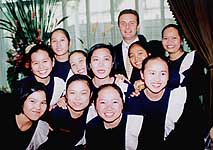 A
‘sea’ of smiling faces with their “new” GM. A
‘sea’ of smiling faces with their “new” GM.
It was more than just a “Certificate of Achievement”
in hotel management and catering, however. The diploma, displayed with
reverence and awe, was also a key - a key which will unlock the door to a
new life for these adolescent girls and young women. Only six months prior
to the training, these bright, lovely young people, selected from the north
and north-east, were enmeshed in the web of grinding poverty which
inevitably leads to a myriad social problems - particularly sexual
exploitation - sometimes ending in depression and despair.
Now, self-assured and confident, they go forward as the
newest contingent of the 327 young ladies - and one young man - who have
graduated from the Youth Career Development Programme (YCDP) since its
inception in 1995. A number of the graduates in the earlier training courses
are now in supervisory positions in several of the hotels participating in
the scheme, while others now work outside the industry in teaching and other
worthy professions.
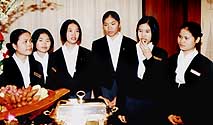 Sampling
the fare: Umm, we cook well! Sampling
the fare: Umm, we cook well!
The YCDP, said William Sayce, general manager of Pan
Pacific Hotels, is an initiative launched in 1995 by the Pan Pacific and the
United Nations Children’s Fund (UNICEF), “As a preventive strategy
against the exploitation of children and youth,” he said.
Starting modestly with just a few seven years ago, this
year 18 of Bangkok’s leading hotels joined the training scheme, namely:
the Grand Hyatt Erawan, Grand Pacific, Holiday Inn Crowne Plaza, JW
Marriott, Le Meridien President, Merchant Court, Novotel Lotus, Novotel Siam
Square, Pan Pacific Bangkok, Pathumwan Princess, Peninsula Bangkok, Regent,
Royal Orchid Sheraton, Shangri-La, Sheraton Grand Sukhumvit, Siam
Inter-Continental, Sukhothai and the Westin Banyan Tree.
The trainees are now proficient in many areas of the
hospitality industry, including food and beverage services, flower
arranging, housekeeping duties, laundry and a myriad of kitchen-related
skills, such as preparing dishes and cooking. They are also taught basic
English and are immersed in a range of “life-coping” skills, preparing
them for a future with hope and promise.
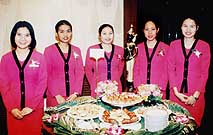 A
food fair - presided over by ‘real beauties’ A
food fair - presided over by ‘real beauties’
The Peninsula’s spacious ball-room and adjacent areas
were laid out with displays of each participating hotel, with the smiling
graduates showing off their newly-acquired skills, floral displays and an
incredible range of food, pastries and fruit. It was like a food fair
presided over by real beauties!
The YCDP model has gained much national attention, as
well as increasing international, and has been the matrix for training
courses designed by the Royal Thai Government’s Skills Development
Department and the Royal Project Foundation’s programmes of teaching
agricultural skills to hilltribe youth.
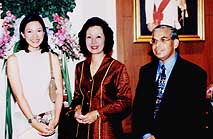 Dr
Kasama Varavan na Ayudya, director general, General Education Department,
flanked by UNICEF youth envoy Kathaleeya McIntosh and UNICEF Representative
Gamini Abeysekera. Dr
Kasama Varavan na Ayudya, director general, General Education Department,
flanked by UNICEF youth envoy Kathaleeya McIntosh and UNICEF Representative
Gamini Abeysekera.
The Ministry of Science is planning to train at-risk
adolescent girls in tissue culture and other aspects of agro-industry.
Elsewhere, YCPD is being adopted by the UK’s Prince of
Wales Foundation for training disenfranchised youth and the International
Hotels and Restaurants Association has incorporated aspects of YCPD in its
world-wide training programmes.
Gamini Abeysekera, representative of the UNICEF Office
for Thailand, was very happy with the, “Collaboration between the hotel
industry, the Royal Thai Government and UNICEF which has brought about these
very positive results.” Mr Abeysekera noted that the livelihood and
life-skills which the girls had acquired through YCPD, will allow them,
“To make a decent living, be able to make wise decisions and thus live a
good life.”
In praising the 18 hotels which have become partners in
this unique programme, Mr Abeysekera pointed out that, through this, the new
graduates can look forward to job security and incomes well above those of
university graduated in the government service.
Gamini’s words were somewhat prophetic, for the very
next day, Irawat Chantaraprasert, permanent secretary for labour and social
welfare, predicted a jobless rate of 1.7 million, including 500,000 new
graduates next year.
Kathaleeya McIntosh, UNICEF Envoy for Youth, a shining
example for the young women to emulate, also addressed the group, beckoning
them forward into a new life of pride, self-esteem and gainful employment.
HIV AIDS in Thailand :
The Road Back or Disaster?
Pattaya Mail special correspondent Peter Cummins has
just completed an in-depth study of some of the tragic repercussions of
HIV/AIDS on the innocent victims, Thai children. Commissioned by the United
Nations Children’s Emergency Fund (UNICEF) in Bangkok, the study focuses
on the northern and the north-eastern regions where HIV/AIDS has been
endemic for more than a decade.
But, through community assistance, particularly the
Sangha (Buddhist monkhood), individuals in the public and private sectors,
UNICEF and related agencies and a spirit of understanding and cooperation
from all touched by the insidious disease, there is hope: an arrest of
infections and a hope for those carrying the HIV virus of returning to a
normal life.
story and photos by Peter Cummins
(exclusive to the Pattaya Mail)
Prologue
For all who have experienced it, the death of a parent is
a very personal loss, a unique situation for every individual, leaving the
bereaved offspring in situations as varied as the human race itself,
depending upon the circumstances surrounding the death.
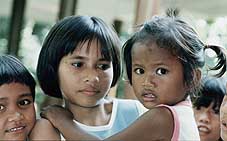 Who
will take care of us when HIV/AIDS strikes? Who
will take care of us when HIV/AIDS strikes?
If the parent who dies is at an advanced age, there is
usually not much trauma for those left behind. Life goes on. But imagine,
for a moment, the death of one or both parents from the ravages of HIV/AIDS,
at a young age, leaving a defenceless child or children to face a hostile
environment and an uncertain future, fraught with hazards.
It is, indeed, a vicious cycle. In Thailand, a child
whose parents have contracted the HIV virus and are mostly doomed to die of
AIDS, is not only inherently disadvantaged by discrimination and the social
mores which place barriers - artificial or real - around the child, but also
must face the physical barriers which are equally devastating. With parents
facing imminent death and too sick to work, the unfortunate - and totally
innocent victims - must seek employment to support them, precluding any
possibility of education.
The child is thus condemned to a life of unskilled work,
lack of social benefits, a total loss of self-esteem and a steady downward
spiral from which there is little or no escape.
Discrimination
Vuth, for example, is a 10-year-old in Grade 4 of a
Primary School in a district of Sisaket Province in Thailand’s north-east.
He would rather roam the woods near his home and go fishing than go to
school where he is ostracised and called the “Aids kid”. Vuth has two
younger sisters - one in Grade 3 who does not have any particular problems -
but the other, even in kindergarten, is subject to teasing about her
HIV-infected mother and she has no ‘playmates’.
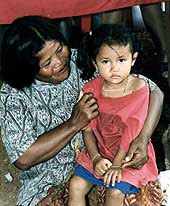 Happy
childhood: but for how long? Happy
childhood: but for how long?
“My children have never done anything wrong in their
lives,” says Vuth’s mother Bua, HIV-infected for six years. “Since
their father died of AIDS, although none of my three children are
infected,” Bua complained, “they cannot live normal lives and they
suffer discrimination at their school, at the market and in the everyday
life of the village.”
In another case, in a neighbouring sub-district, Aree and
her two sisters were alone with their HIV-infected mother and were the
object of much discrimination at Primary School. When their mother became
too sick to work and support the family, Aree’s elder sister had to leave
school to take on the role of family provider - at age 12!
Aree continued at school, in spite of being “left
out” and, although she likes to study, she will leave after Grade Nine.
“After that, I do not know what I will do. I have nobody with whom I can
discuss my problems; no friends; I eat lunch alone; and none of the others
in class want me to join group projects,” said this sad little child,
tears welling in her huge, pretty brown eyes.
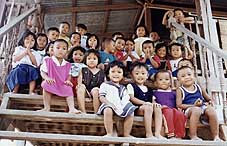 We
have done nothing wrong We
have done nothing wrong
Even further down the scale are AIDS orphans who, having
lost both parents, are in the custody of ‘carers’, often grandparents
who are old, and in most cases, desperately poor. A child, already
psychologically scarred - even if not afflicted with symptoms of HIV - faces
a generation gap with these aged grandparents which, added to grinding
poverty and often lack of schooling, can lead many youngsters to take to a
life as street children and, worse, child prostitution and its concomitant
destructive forces.
This is an oft-repeated scenario that would haunt any
mother - anywhere. Yet, for some 200,000 Thai children, poised at the dawn
of the New Millennium, it is the only world they know - and, maybe, will
ever know.
Hope and strength in adversity
But from the bleakness of the plight of these children,
help from many sources, including UNICEF, the UN Joint Programme on
HIV/AIDS, Buddhism (the Kingdom’s religion), teachers, the public and
private sectors, health and social workers and a legion of volunteers,
brings hope and strength.
Through the “Sangha” (Buddhist monkhood), many
children, either orphans or with one surviving - albeit ailing from HIV and,
thus, dependent - parent, have found solace in their grief, gained
confidence and new directions in life.
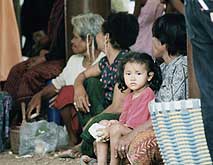 Counselling
and support groups help ease the pain and sorrow Counselling
and support groups help ease the pain and sorrow
Manit Sricome was 12 years old when her step-father died
of AIDS. Her biological father and her mother Noi had divorced when she was
only four and her stepfather tested HIV positive which developed into the
fatal disease. Manit was traumatized to learn that the mother she adored had
also tested positive for HIV.
What can a 12-year-old do, faced with an ailing mother
and two siblings, a little brother of eight and a baby sister, from the
stepfather, just five years old? The family was shattered while, at the same
time, ironically enough, their dire circumstances brought them closer
together.
Friends and relatives in the village, too, rallied around
and, “Mum joined an HIV/AIDS victim support group. We nursed each
others’ hearts,” said Manit, gesticulating with her slender hands and
pointing to her heart.
“My mum can still work and she is a seamstress, making
robes at Wat (temple) Hua Rin (located in Thailand’s northern Chiang Mai
Province),” Manit said, with a winsome smile. “She earns about Baht100
($US2.50) a day which, added to my own income, allowed me to complete
primary school and enter a vocational training school, where I learn
cooking.”
It was also at the temple where Manit learned her
flower-arranging skills, making garlands and bouquets for festivals and
special occasions, also earning about Baht100 per day to support her mother
and siblings. “People these days must have flower arrangements for
weddings and other ceremonies,” said the earnest little girl.
With a wisdom far beyond her tender years, no doubt
tempered by her hardships, she said, “Even people who are rough and
ill-mannered can change their nature when they look at flowers,” adding as
an after-thought, “Women are attracted to flowers, too...our hearts go
with flowers.”
She also learned classical Thai dancing and helped with
cooking at the temple. “I am only small, but my hands are strong and I use
them to help our family,” she said, displaying finely-formed hands and
slim, long fingers.
“My teacher Ms Pranee was a great source of help and
consolation during those grim years,” Manit recalled recently. Ms Pranee
told me to give mama as much support as I could. “We - mum and I - became
very close during that time,” Manit remembered. “Being close to mum
showed her that, even at my young age, I accepted things as they were.”
“Do you like doing work where you can use your
hands?” Manit was asked. Her profound reply was an insight into a
determined, strong mind: “I’m good at things where I can use my hands.
It’s like things that endure have colours that are soft. By using our
hands, we can do things that our minds can’t achieve. When it comes from
my own hands I feel proud. It’s the result of my own skill and the money I
earn makes mum happy and helps us all,” she answered.
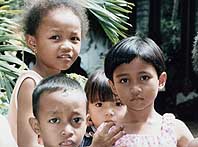 HIV/AIDS
looms on the horizon for these happy children HIV/AIDS
looms on the horizon for these happy children
I could not help but reflect how care-free and easy my
own upbringing had been: a life with healthy parents, good circumstances and
a rosy future. A life full of laughter and joy where daily necessities were
taken for granted - or, even, as a birth-right, through having had the good
fortune to be born in a prosperous, stable society.
On the contrary, many of the very basic needs are simply
just not available to a huge number of poor and marginalized people in
Thailand, especially those in the disadvantaged north and north-eastern
regions. In my childhood, the most basic of resources, water, for example,
came from faucets - an endless flow of clean, clear water, even hot or cold,
at the turn of a tap. In a number of Thailand’s regions, for many,
life-giving water for consumption, hygiene and crops is a dubious-looking
brown colour, coming from a bucket carried a long distance.
I was considerably chastened by the circumstances and
tragedy which enveloped this sweet child - now a teenager - who, like her
mother, is totally innocent and who, as she said it so poignantly, “I am
the medicine to treat my mother”. She wanted to save enough money from her
various after-school activities - “to finish building the house so that
mum will be happy.”
Manit’s mother found peace and friendship at Wat Hua
Rin, whose abbot, Athikarn Thanawat Tekapanyo, affectionately known as Luang
Pi Daeng, ministers to the AIDS-inflicted and AIDS-affected through the
temple’s AIDS-support project. The temple is located in the Tung Sa Tok
sub-district, San Patong District of Chiang Mai Province, in the northern
region of Thailand where HIV/AIDS is most prevalent.
The will to succeed
Manit’s suffering has endowed her with a physical and
inner strength which has not gone un-noticed by authorities. In her darkest
days, she was the school ‘dunce’, but her courage and determination
shone through and, in October this year, Manit had made such progress that
she was selected as the Thai delegate to the Sixth International Congress on
AIDS, held at Melbourne, sponsored by the UN Joint Programme on HIV/AIDS.
She noted that the help and guidance from Abbot Luang Pi
Daeng, her teacher and many other understanding people gave her the
confidence and determination rise above life’s problems to such an extent
that she is now an AIDS educator to her age group.
Manit’s message to the AIDS Congress is that she wants,
“Other teenagers to learn from my experience - whether affected by
HIV/AIDS or not. They should never give up... but fight and act wisely to
move on and live a normal life,” she counsels her peer group.
Perhaps, in the near future, with her obvious abilities,
Manit could be eligible for an upcoming Youth Career Development Programme,
a joint collaboration between UNICEF, leading hotels and the Royal Thai
Government. In its seven years of operations, almost 330 disadvantaged young
girls from the north and north-east have graduated, proficient in the hotel
and hospitality industry, to go forward into productive, fulfilling lives,
far removed from the spectre of a tragic future.
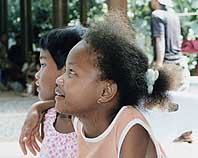 Facing
a grim future as victims of HIV/AIDS-afflicted parents Facing
a grim future as victims of HIV/AIDS-afflicted parents
Another outstanding case of a youngster rising above
HIV/AIDS-inflicted adversity is 17-year-old Thai boy Khomsan Sangsuengmoo.
When aged only 15, Khomsan was selected, together with a teenaged girl from
Uganda, to represent 13 million AIDS orphans world-wide at the AIDS Orphans
Symposium. Held at the United Nations New York Headquarters on World AIDS
Day, 1 December, 1999, the gathering of more than 800 people, including
heads of state, was supported by UNICEF and the UN Joint Programme on
HIV/AIDS.
Khomsan Sangsuemoon, who had never before left his
village in Chiang Rai’s Mai Chan District in the north-east of Thailand,
drawing strength from his tragic life fearlessly addressed the symposium
with a message heard loud and clear around the world.
This brave, sad boy, with the quiet voice and the
self-effacing demeanour brought on by his suffering and loneliness, informed
an emotionally-charged assembly that, “AIDS had killed the two people I
love most - my parents”. The 15-year-old Grade 8 student’s plea,
presented to the world with a maturity belying his youth, was a request, on
behalf of all the children who share his fate, including one million
HIV-positive in Thailand, for simply “some support and opportunity”.
Khomsan had lost his surviving parent when his father
succumbed to the disease. He was only 12 then and had not even known his
mother who died from AIDS-related complications before his first birthday.
Information - The Key
As with almost all facets of life - whether from the
western viewpoint or in a country like Thailand - it is information and
education which are the keys to understanding any given topic - even the
most controversial. Abbot Luang Pi Daeng soon learned when he launched his
AIDS-support project six years ago that he had to convince the local and
provincial authorities, the community doctors, nurses, teachers and staff of
the local administration, to accept HIV/AIDS victims as REAL people, able to
work and contribute to the community.
Wat Hua Rin has been exemplary and its AIDS/HIV
assistance programmes have been a blueprint for many others in the region.
The abbot himself, upon the death of his own mother, went as a child to live
and study at the temple and wanted to repay the community. The Prasanjai
Group (literally meaning ‘collective will’), which he established to
offer shelter to infected women, has been highly successful. His campaign of
education and information throughout all echelons of the community is paying
handsomely and, as a result, said the abbot, “There has been a reduction
of HIV cases and those already infected now have a better quality of
life.”
The abbot believes that, whether in the school
environment or the community at large, ostracism and discrimination stem
from a lack of information, rather than any inbred hostility. As long as
people, young or old, do not have access to the factual information about
AIDS and its transmission, these prejudices will always exist.
Unlike many western societies, where individual rights
are protected and discrimination is forbidden by law, Thailand, even under
the new Constitution safeguarding these personal freedoms, is only slowly
accepting a legal approach. Rather, it is the age-old traditions of
compassion and sympathy, coupled to an understanding of the magnitude of the
problem, which will help alleviate the stigma surrounding HIV/AIDS and
perhaps in the long-term, help eradicate the disease altogether.
Epilogue
The HIV/AIDS problem is immense and will not go away.
Much assistance is needed for the “hidden sufferers” - the innocent
children - and, thus, it is essential to implement HIV education programmes
BEFORE any parental death occurs.
All available resources - financial, human and technical
- must be brought to the front-line of what is, basically, a battle for the
safety and well-being of future generations.
UNICEF will continue to lead the fight against HIV/AIDS.
Conspiring with
Nostradamus
by Barry Kenyon
Within days of the World Trade Center catastrophe, the
best selling books at Amazon.com concerned the prophecies of Nostradamus.
Meanwhile, web search engines staggered under the sheer number of enquiries.
Maybe, just maybe, the whole thing had been predicted by a sixteenth century
French potato head. The Internet became crowded with revelations about what
he had supposedly written. Perhaps the best known example is, “On the 11 th
day of the 9th month, two metal
birds will crash into two tall statues in the new city, and the world will
end soon after.” Pretty convincing stuff except that Nostradamus never
wrote anything of the sort. It’s bogus pure and simple.
Over the centuries, Nostradamus has been credited with
prophesying murky futures down to the last detail. Examples include the
French Revolution, the rise of Hitler (Hister in the original
quadrains is actually an area of the lower Danube), the sinking of the
Titanic and so on. Actually his flowery prose and riddles can be made to fit
any dire event, provided it has already happened of course. The one
undeniable truth that Nostradamus never predicted is that some wise guys
would still be making a huge profit out of his ambiguous verses in the
twenty first century. If he could have copyrighted his work for all time,
his fortune today would outclass that of Bill Gates.
Never mind, the whole world loves a conspiracy theory.
Web sites have posted pictures of the September 11 US tragedy in which the
face of Satan can supposedly be glimpsed in the billowing smoke. Others have
argued that you can make out an alien craft or even a Tomahawk helicopter
observing the hijacked planes just before the crashes. So maybe the
government knew of the attack or screwed up the defence, or worse, perhaps
evil aliens from other galaxies have already penetrated the White House and
masterminded the tragedy. There is no bottom to this particular pit.
Numerologists have had a field day with the number
eleven. The twin towers of WTC resembled two number ones. The US emergency
number 911 is the date of the disaster. Words like The Pentagon, New York
City and Afghanistan each have eleven letters. As any statistician will
confirm, coincidences abound in any event if you look for them. If WTC had
been hit on the thirteenth of the month, we should doubtless be reminded
that Osama bin Laden, Saddam Hussein, Mother Shipton and George Bush Jnr
also happen to have that total in their names.
But there is no denying the fantastic human interest in
these silly stories. How to explain it is the problem. Most of we ordinary
guys and gals live in a world which we feel increasingly powerless to
influence. We watch TV programs about space satellites whilst knowing deep
down we shall need to call in an electrician if the fridge breaks down. Few
of us have much real understanding of advanced new technology, so we have to
swallow what the technocrats, the de facto ruling class, tell us. As any
public opinion poll will demonstrate, we are generally suspicious of
governments and believe they are manipulating us. This is well shown in the
much wider controversy about UFOs. If our governments utter denials about
alien visitations in principle, then there’s probably something in the
stories. And, indeed, sometimes there could be.
The breakdown of religious values in so called Christian
societies may also play a part. We need a substitute belief system or
perhaps are on the lookout for one. There are certainly more tarot card
readers in business today than throughout history. Most newspapers carry
horoscopes and such research as there is suggests more people peruse those
daily than the movements on the world’s stock exchanges. Movies about the
end of the world or uncontrollable plagues and infestations are huge box
office successes. And conspiracy theories, however improbable, are also part
of the new order controlled paradoxically by the free access Internet. Any
lingering doubts were removed on September 11, 2001.
Updated every Friday
Copyright 2001 Pattaya Mail Publishing Co.Ltd.
370/7-8 Pattaya Second Road, Pattaya City, Chonburi 20260, Thailand
Tel. 66-38 411 240-1, 413 240-1, Fax: 66-38 427 596
Updated by
Chinnaporn Sungwanlek, assisted by Boonsiri Suansuk.
E-Mail: [email protected]
|

The Rotary Club
of Jomtien-Pattaya

Skal
International

Pattaya
Fun City
By The Sea

www.pattayarotary.org
|
 His
Majesty King Chulalongkorn the Great
His
Majesty King Chulalongkorn the Great William
Sayce, GM, Pan Pacific and his new staff. Dr Kasama at far right
William
Sayce, GM, Pan Pacific and his new staff. Dr Kasama at far right A
‘sea’ of smiling faces with their “new” GM.
A
‘sea’ of smiling faces with their “new” GM. Sampling
the fare: Umm, we cook well!
Sampling
the fare: Umm, we cook well! A
food fair - presided over by ‘real beauties’
A
food fair - presided over by ‘real beauties’ Dr
Kasama Varavan na Ayudya, director general, General Education Department,
flanked by UNICEF youth envoy Kathaleeya McIntosh and UNICEF Representative
Gamini Abeysekera.
Dr
Kasama Varavan na Ayudya, director general, General Education Department,
flanked by UNICEF youth envoy Kathaleeya McIntosh and UNICEF Representative
Gamini Abeysekera. Who
will take care of us when HIV/AIDS strikes?
Who
will take care of us when HIV/AIDS strikes? Happy
childhood: but for how long?
Happy
childhood: but for how long? We
have done nothing wrong
We
have done nothing wrong Counselling
and support groups help ease the pain and sorrow
Counselling
and support groups help ease the pain and sorrow HIV/AIDS
looms on the horizon for these happy children
HIV/AIDS
looms on the horizon for these happy children Facing
a grim future as victims of HIV/AIDS-afflicted parents
Facing
a grim future as victims of HIV/AIDS-afflicted parents

